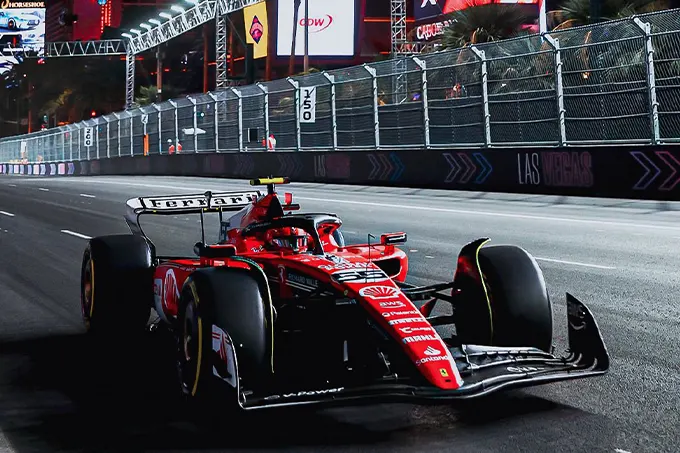Ferrari braces for Las Vegas GP, a one-of-a-kind F1 event demanding precision, adaptability, and mastery of unique night racing conditions.
Ferrari is gearing up for one of the most unique races on the F1 calendar, the Las Vegas Grand Prix, taking place this weekend in Nevada. Erik van der Veen, the engineer in charge of Maranello’s simulator, outlined the challenges awaiting the Scuderia.
“Las Vegas is one of those circuits that may seem easy at first glance but is actually very difficult for various reasons. There are only five corner sequences,” Van der Veen stated.
“But they are all low-speed with large braking zones, and some corners are blind. These large braking zones must be timed perfectly, even when driving at over 340 km/h.”
“This requires a lot of downforce to provide the confidence needed to slow the car, navigate through, and exit these corners as quickly as possible. On the other hand, as soon as you exit these corners, there are long straights that demand low drag and therefore a low-downforce setup.”
“Then again, at the end of these straights, you face large braking zones, but by then, the brakes and tires have cooled down after not being used during the entire straight, adding another layer of difficulty for the drivers to manage.”
“All of this is on a street circuit where the walls are very close, leaving no room for error. Las Vegas is in a desert, and the event takes place at night.”
“This means temperatures drop very quickly, sometimes even below 10 degrees Celsius, making it hard to get the tires into the optimal window for a single push lap and equally hard to keep them there during longer runs.”
“This challenge is compounded by the long straights, which allow the tires to cool rapidly, presenting drivers and teams with problems they don’t encounter on any other circuit.”
In 2023, “the simulator was based on drawings.”
The simulator has been crucial for preparing this race, and Van der Veen highlights the difference between 2023 and 2024, with a year of experience: “If we compare what we knew last year to what we know this year, the situation has completely changed.”
“While last year, the track model used in the simulator was based on drawings, this year we have a full representation of the track, the asphalt, and its surroundings.”
“Moreover, since we also have all the data from last year, we can predict much more accurately what will happen during this year’s Las Vegas GP.”
“This means that not only the engineers and development drivers but also Carlos and Charles themselves have a much better opportunity to prepare for the weekend, familiarize themselves with the track, and fine-tune the car’s setup.”
“As with every race, Charles and Carlos were in the simulator ahead of the event, working on optimizing their driving and the car setup to ensure we have the best possible starting point, as well as being ready in case conditions differ from what we expect.”
“This is precisely when the simulator becomes an extremely powerful tool, and the preparation sessions prove invaluable in helping drivers optimize their driving style for a specific circuit.”
The Importance of the Simulator Driver
Despite the significant learning curve Las Vegas presents, Ferrari is approaching this race like any other, with thorough work by the simulator driver and simulations of various weather scenarios: “The approach is no different from that adopted for any other event, even if the circuit is one of a kind.”
“The development driver in the simulator will have been briefed during weekend preparation on the importance of optimizing every corner, given there are very few sequences where the drivers can make a difference.”
“It is crucial for the drivers on the circuit to have a car that gives them the confidence to push to the limit without exceeding it, as the corners are tight and blind.”
“The simulator driver therefore focuses much of their attention on balance and driving style through these corners, sometimes even exceeding the limit and hitting the walls — thankfully, in the simulator, the damage isn’t real.”
“During a typical session where we assist the team at the track, we use the laps completed during free practice sessions and replicate the exact same conditions, car setup, and driving style in the simulator.”
“This allows us to identify the car’s strengths and weaknesses and work on improving them to provide feedback to the trackside team, enabling them to adjust the car accordingly.”
“We also use these sessions to explore what to expect if the weather changes during the weekend — for example, temperatures, wind direction, and intensity can vary from day to day or even during a single session.”
“By reproducing these weather conditions in the simulator, we can inform the drivers about what to expect, allowing them to extract maximum performance from the car before they even hit the track.”
- Discover More>Piastri Refutes Qualifying Compromise Amidst Norris’s Dominance
- Follow us on >Facebook and >Twitter for F1 updates.
Las Vegas GP: Tight Turns and Nighttime Racing Drama Las Vegas GP: Tight Turns and Nighttime Racing Drama f1 2024 Las Vegas GP: Tight Turns and Nighttime Racing Drama
